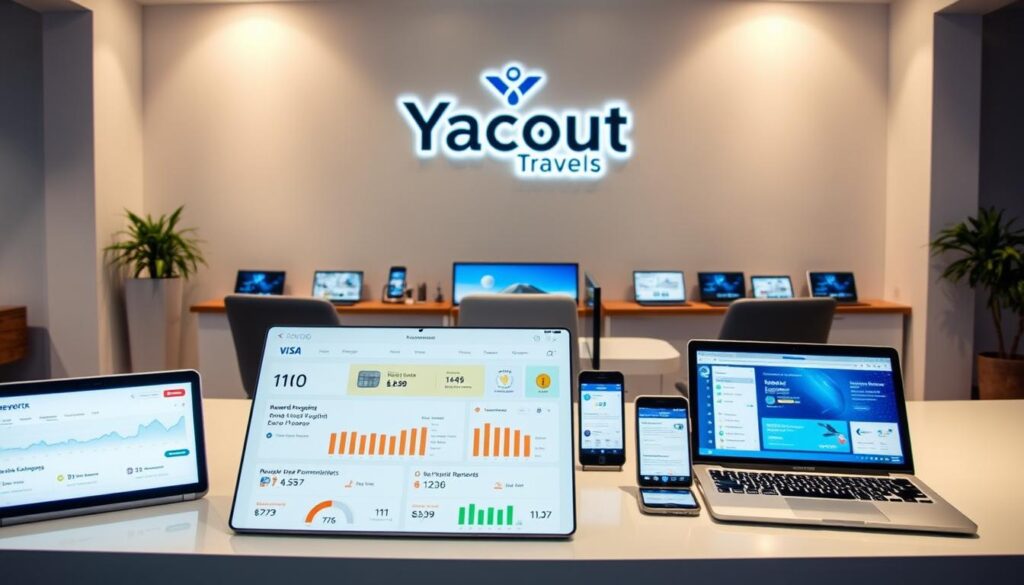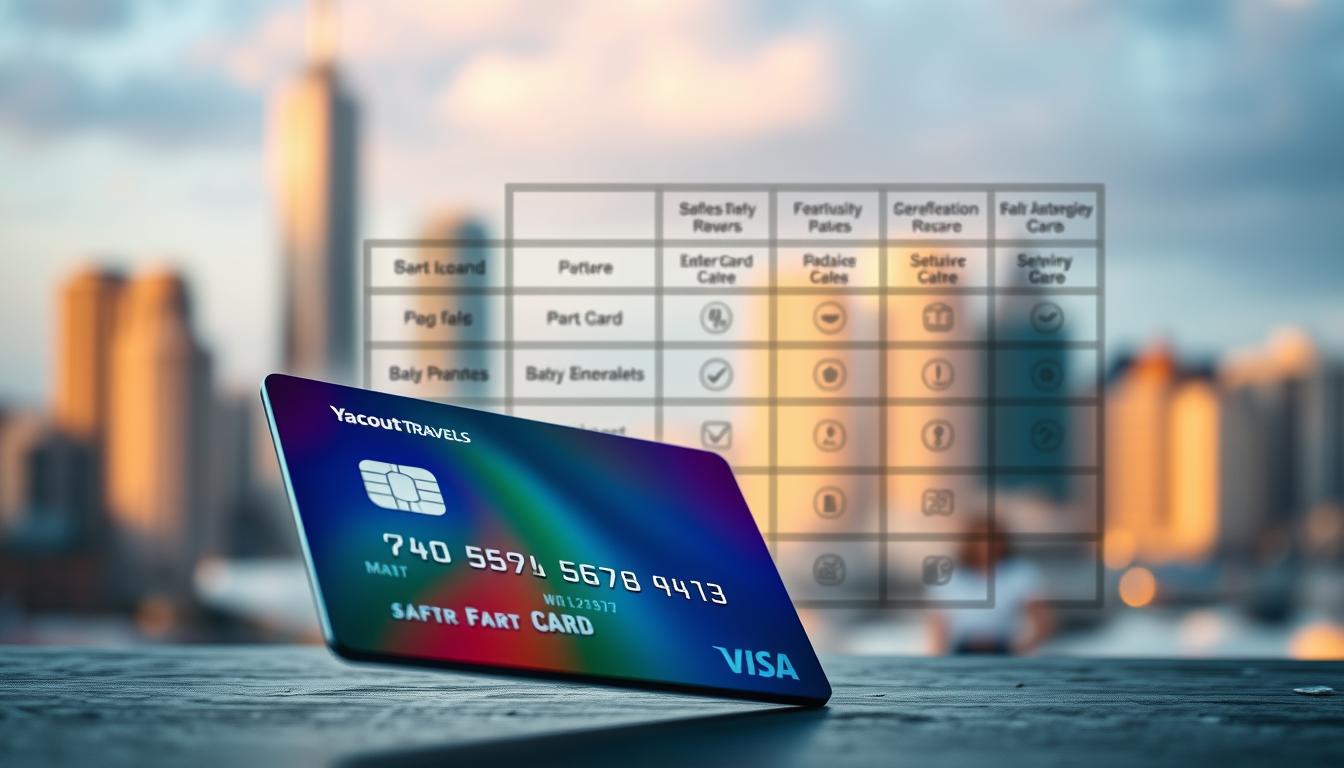The Visa Trick That Saves You Hundreds
Imagine visiting over a dozen countries in just three years without breaking the bank. This isn’t a fantasy real families are doing it right now using smart financial strategies.
What if your everyday purchases could fund your next adventure? This approach turns regular spending into valuable rewards. Many people discover they can earn enough for flights and hotels just by managing their finances wisely.
The secret lies in understanding how to maximize credit card benefits. You can accumulate points and miles that are worth far more than their face value. Strategic spending becomes your ticket to affordable adventures around the world.
This method isn’t about complex schemes or risky behavior. It’s a well-planned approach that leverages sign-up bonuses and daily expenses. The key is paying off your balance every month to avoid interest charges.
You’ll see how responsible financial habits can unlock incredible value. People regularly save thousands on premium flights and luxury accommodations. Your journey toward smarter spending starts here.
Introduction to the Visa Travel Hack Beginner’s Guide
Your daily spending habits could be the key to unlocking extraordinary adventures worldwide. This beginner’s guide walks you through everything from basic concepts to advanced strategies.
What You Will Learn
You’ll gain a solid foundation in how this approach works. The guide covers earning methods and redemption strategies for maximum value.
Discover which financial tools offer the best rewards. Learn to turn everyday purchases into flights and hotel stays.
Why This Matters for Your Budget
This strategy makes your money work harder for you. It transforms routine expenses into valuable points and miles.
Many families have saved thousands on premium experiences. They enjoy luxury accommodations and business class flights at a fraction of the cost.
| What You’ll Master | Key Benefits | Time Investment |
|---|---|---|
| Earning strategies | Maximize everyday spending | Ongoing practice |
| Redemption techniques | Best value for points | Initial learning curve |
| Card management | Avoid interest charges | Monthly attention |
Remember to always pay your balance in full each month. Interest fees can quickly erase any rewards you earn.
Understanding the Visa Travel Hack
Strategic financial planning can transform your shopping habits into incredible adventures. This approach helps you maximize value from everyday expenses.
Defining the Concept
This method involves using financial tools to accumulate valuable benefits. You earn points through regular purchases instead of paying cash.
The strategy turns routine spending into premium experiences. Many people enjoy luxury accommodations and flights at significant savings.
The Role of Credit Cards in Travel Savings
Financial institutions offer generous sign-up bonuses to attract customers. These initial rewards provide a quick boost to your balance.
Different cards provide various earning rates on purchases. Some offer bonus categories for groceries, dining, or gas stations.
Responsible management is crucial for success. Always pay your balance in full to avoid interest charges that negate your earnings.
| Strategy Component | How It Works | Potential Value |
|---|---|---|
| Sign-up Bonuses | Meet spending requirements for initial points | High immediate return |
| Category Bonuses | Earn extra on specific purchase types | Ongoing accumulation |
| Redemption Options | Transfer points to airline/hotel partners | Maximum value per point |
Understanding these components helps you make informed decisions. You can choose the right financial products for your spending patterns.
The Foundations of Travel Hacking
The world of loyalty programs has its own vocabulary that, once learned, reveals hidden value in your purchases. Understanding these terms helps you navigate rewards systems effectively.
Basic Terminology You Need to Know
You’ll encounter several key concepts when exploring points systems. Loyalty programs are the frameworks companies use to reward customer activity.
Fixed points and miles stay within specific programs. Transferable points offer flexibility across multiple systems.
Redemption value measures what your rewards are worth. Award charts show how many points you need for different rewards.
Transferable vs. Fixed Points Explained
Fixed loyalty points are tied to specific programs like Delta SkyMiles or Hilton Honors. They can only be redeemed within their original programs.
Transferable credit card points come from programs like Chase Ultimate Rewards and Amex Membership Rewards. These offer incredible flexibility since you can move them to various airline and hotel partners.
The magic happens when you transfer points strategically. You might get 5 cents per point instead of just 1 cent through basic redemptions.
Calculate value using: (Cash Price – Taxes) / Points = Cents Per Point. This helps determine if a redemption offers good value.
Navigating Credit Card Essentials for Travel Rewards
Your choice of plastic can dramatically shape your ability to earn valuable points for future adventures. Understanding the two main categories helps you build a strategy that matches your spending patterns and goals.
Types of Credit Cards: Co-branded vs. General Rewards
Co-branded credit cards partner with specific airlines or hotels. They earn fixed loyalty points that stay within one program.
Examples include the Delta SkyMiles American Express and Marriott Bonvoy Boundless. These cards often provide brand-specific perks like free checked bags.
General rewards cards offer flexible points you can transfer to multiple partners. The Chase Sapphire Preferred and American Express Platinum card fall into this category.
These provide greater redemption value through transfer options. You can move points to various airline and hotel loyalty programs.
| Card Type | Key Feature | Best For |
|---|---|---|
| Co-branded Cards | Brand-specific benefits | Loyal customers of one brand |
| General Rewards Cards | Transferable points | Flexibility across multiple programs |
Major issuers include Chase, American Express, and Capital One. Annual fees range from $49 to $895, but valuable perks often offset these costs.
For most people, general rewards cards provide the highest value. Their transferable points offer maximum flexibility when planning trips.
Earning Miles and Points with Credit Card Sign-Up Bonuses
Opening the right financial account can instantly boost your rewards balance significantly. Welcome offers provide the quickest method for building your points portfolio from scratch.
These initial promotions typically require meeting a spending threshold within your first few months. For example, you might need to spend $4,000 in three months to earn 75,000 points.
Strategies to Maximize Your Initial Bonus
Time your applications around major planned expenses. Home renovations, vehicle down payments, or insurance premiums can help you meet requirements naturally.
Premium cards like the Chase Sapphire Reserve and American Express Platinum often offer 100,000+ point bonuses. This single welcome offer could cover an international trip with flights and hotels included.
Even with a modest budget, you can concentrate regular expenses on your new credit card. Both partners in a household can apply separately, potentially doubling your bonus earnings.
Track your spending progress using spreadsheets or apps. This ensures you meet deadlines and don’t miss out on valuable rewards from your new credit card.
Everyday Spending and Reward Earning Strategies
Every purchase you make presents an opportunity to build your rewards portfolio. Smart spending habits turn routine expenses into valuable benefits.
How to Optimize Your Daily Purchases
Different financial products offer varying earning rates. Most provide a base of 1 point per dollar spent.
Some cards like Capital One Venture X earn 2 points on all purchases. Others offer elevated rates for specific categories.
The Chase Sapphire Preferred earns 3x on dining. You maximize earnings by using the right card for each purchase type.
Using Shopping Portals for Extra Points
Shopping portals offer bonus points for online purchases. Southwest and American Airlines have their own portals.
Simply click through their website before shopping. You earn additional loyalty points on purchases you were already planning.
Many banks also have shopping portals with extra rewards. Merchant offers in credit card apps provide statement credits too.
| Earning Method | How It Works | Potential Bonus |
|---|---|---|
| Category Bonuses | Use specific cards for dining, groceries | 3x-5x points per dollar |
| Shopping Portals | Click through airline/bank websites | 2x-10x bonus points |
| Merchant Offers | Activate deals in card apps | Statement credits or bonus points |
Switch from cash to credit for utilities and subscriptions. Over a year, these small changes accumulate significant rewards.
Decoding Loyalty Programs and Award Redemptions
Understanding how different loyalty schemes operate is crucial for maximizing your redemption opportunities. These free programs create structured pathways to turn your accumulated benefits into memorable experiences.
Before transferring any points, you must create free accounts with your preferred airlines and hotels. Major programs include American Airlines AAdvantage, Delta SkyMiles, and United MileagePlus for flights.
Understanding Airline and Hotel Loyalty Schemes
Hotel programs like Marriott Bonvoy, Hilton Honors, and Hyatt World of Hyatt each offer unique benefits. Your account names must match exactly between your credit card and loyalty accounts for successful transfers.
Once you move points to a specific program, they become fixed to that brand. Only transfer when you’re ready to book your award stays or flights.
Different programs use various redemption structures. Some maintain fixed award charts with predictable pricing. Others employ dynamic pricing that changes with demand.
Always include your loyalty number on reservations to earn points toward status tiers. Airline programs organize into three global alliances: SkyTeam, Star Alliance, and Oneworld.
These alliances let you book flights on partner carriers using your accumulated miles. This flexibility opens up incredible travel possibilities worldwide.
Maximizing Redemption Value for Your Rewards
Your hard-earned rewards can deliver vastly different value depending on the redemption method you choose. Understanding pricing structures helps you get premium experiences for fewer points.

Fixed Award Charts vs. Dynamic Award Pricing
Fixed award charts set point requirements in advance. These rates stay constant regardless of demand or cash prices.
Hyatt hotels use this system. During high-demand events, fixed charts offer incredible value. A recent example shows 36,000 points saving $1,600 on hotel nights.
Dynamic pricing adjusts point costs based on market conditions. Airlines like Delta use this approach. Sometimes you find amazing deals, other times poor value.
Virgin Atlantic offered a business class flight for 34,800 points plus taxes. The cash price was $6,200, creating massive savings. This demonstrates dynamic pricing’s potential.
Calculate your redemption value with this formula: (Cash Price – Taxes Paid) / Points = Cents Per Point. Aim for returns above 1-2 cents per point.
Fixed charts provide consistency during peak seasons. Dynamic systems require more research but can yield exceptional returns. Knowing both helps maximize every point’s potential.
Real-Life Examples of Successful Travel Hacking
Seeing concrete results from others can give you the confidence to start your own rewards journey. These real-world examples prove that consistent strategies lead to memorable experiences.
Case Studies and Personal Stories
One family visited over a dozen new countries in just 36 months using smart rewards strategies. They took multiple international trips each year that would otherwise be unaffordable.
Their adventures included four flights to Hawaii in 2015 and European journeys to Germany and the Netherlands. In 2022, they enjoyed Spain and Portugal using accumulated points.
Recent savings demonstrate incredible value. A couple paid only $83 CAD per person for flights to Barcelona and from Lisbon. This saved $4,294 compared to the $2,230 retail price per ticket.
Weekend getaways also become affordable through this approach. One traveler flew to Portland for a concert and took road trips with covered hotel stays.
Organization is key to success. A dedicated rewards enthusiast tracks 133 household accounts with nearly 10 million miles and points. They maintain an excellent 840 credit score while managing multiple financial products.
These examples show how strategic planning turns everyday spending into extraordinary adventures. Your journey toward similar success begins with consistent, organized effort.
Comparing Popular Travel Credit Cards and Their Benefits
Choosing the right financial tool is a critical step in maximizing your rewards strategy. This comparison helps you see how annual fees are often offset by valuable credits and perks.
Highlighting Key Perks and Annual Fee Justifications
The Capital One Venture X has a $395 annual fee. You get a $300 travel credit and 10,000 bonus points each year.
This effectively makes the fee minimal. You also receive lounge access and a TSA PreCheck credit.
The American Express Platinum card has a higher fee. Starting late 2025, it will be $895 per year.
This cost is balanced by over $1,500 in statement credits. Benefits include Uber credits, airline fee credits, and lounge access.
This card earns 5x points on airfare, making it ideal for flight purchases.
The Chase Sapphire Preferred offers great value for a $95 annual fee. You get monthly DoorDash credits and 3x points on dining.
It also provides primary car rental insurance. This protects you without involving your personal auto policy.
Hotel cards like the Chase Hyatt and IHG Premier also justify their fees. They provide a free night annually, which often covers the cost.
Many premium cards include valuable insurance benefits. These can cover trip cancellations, lost baggage, and purchase protection.
Staying organized with these credits means the cards pay for themselves. You can come out ahead each year with smart management.
How to Use Points for Hotel Stays and Flight Bookings
Turning your accumulated rewards into actual trips requires mastering specific booking techniques for both accommodations and flights. This process involves understanding availability searches and partnership networks.
Booking Strategies for Award Nights
Start by logging into your hotel loyalty account on their website or app. Search for your desired dates and toggle the “Use Points” option to check award availability.
Chase Ultimate Rewards stand out as the only major transferable points that move to World of Hyatt. This partnership is especially valuable due to Hyatt’s fixed award chart.
Some hotel programs offer excellent perks for longer stays. The IHG Rewards Credit Card provides a 4th night free on award bookings. Hilton Honors members with status enjoy a 5th night free on standard room stays of five nights or more.
Leveraging Airline Alliances for Better Deals
Understanding the three major airline alliances opens up global booking opportunities. These networks include SkyTeam, Star Alliance, and Oneworld.
Partner airlines within these alliances often sell the exact same flight but require different amounts of miles. You might find significantly better value by checking the same route across multiple programs.
Knowing major US airline hubs helps you identify which alliance works best from your home airport. Delta dominates Atlanta and Detroit, while United controls Chicago O’Hare and Denver. American Airlines focuses on Dallas and Charlotte.
This knowledge lets you book flights on carriers like Air France or Singapore Airlines using points from different loyalty programs. Always compare options within an alliance to find the best redemption value for your miles.
Tools and Apps to Manage Your Rewards Effectively
Managing multiple rewards accounts becomes simple with the right digital tools. These apps help you track your growing collection of credit cards and loyalty programs without feeling overwhelmed.

Award Wallet stands out for tracking reward programs. It monitors 678 different loyalty programs under one login. You can see all household members’ accounts and points balances together.
For broader financial tracking, try Empower. This free tool shows your credit cards, bank accounts, and investments in one dashboard. You get a $20 Amazon gift card just for signing up.
Monarch Money offers advanced features if you need more than free options. Founded by an ex-Mint employee, it provides excellent budgeting and detailed reports.
Password managers become essential when juggling dozens of accounts. Options like Bitwarden, LastPass, and 1Password keep your login information secure and organized.
Create a Google Docs spreadsheet to track each credit card’s details. Record application dates, bonus requirements, and spending progress. This helps you meet all deadlines for maximum rewards.
SaveWise shows offers from over 20 shopping portals simultaneously. It stacks with Chase and Amex card offers to ensure you always choose the highest rewards rate.
Don’t forget physical organization. A card holder case helps you keep track of your multiple cards. This ensures you use the right one for each purchase category.
Staying Organized: Tracking Your Miles and Credit Cards
As your rewards collection grows, staying organized becomes your secret weapon for maximizing every point. Good tracking habits prevent missed opportunities and keep your strategy on track.
Using Digital Trackers and Spreadsheets
Make it a habit to check your reward balances every couple of months. This regular review keeps earning rewards front of mind.
Many people find tracking feels like a fun game. Watching your points grow provides motivation to continue optimizing.
You have several options for managing your balances. Digital tools offer convenience, while manual methods increase engagement.
| Tracking Method | Best For | Key Advantage |
|---|---|---|
| Digital Apps | Quick updates | Automatic balance checks |
| Spreadsheets | Detailed planning | Customizable categories |
| Printable Trackers | Visual learners | Increased engagement |
Don’t forget to monitor your credit score regularly. Many banks offer free score monitoring services. This helps you understand how your activities affect your financial health.
Having a system prevents the common problem of neglected reward cards. Serious points collectors consistently check their balances and deadlines.
Overcoming Common Pitfalls in Travel Hacking
Many people hesitate to start this journey because they worry about their financial health. Understanding the rules prevents costly mistakes.
The most important rule is paying your balance in full every month. Interest charges can wipe out your rewards quickly.
Avoiding Credit Card Debt
This strategy only works if you never carry a balance. If you struggle with credit management, this approach isn’t for you.
Responsible use means treating your card like cash. Pay off purchases immediately to avoid debt.
Ensuring Your Credit Score Stays Healthy
People often fear multiple applications will hurt their score. When managed correctly, your credit can actually improve.
Your score breaks down into five components:
- Payment history (35%)
- Credit utilization (30%)
- Length of credit history (15%)
- New applications (10%)
- Credit mix (10%)
New cards affect only 10% of your score. Good payment history and low utilization make up 65%.
One person maintains an 840 score with 24 open cards. Temporary dips after new applications quickly recover.
You can check your score for free through online banking. Monitoring helps you track your financial health.
Remember to use annual fee credits and track expiration dates. Organization protects both your rewards and your credit.
Actionable Tips to Kickstart Your Visa Travel Hack Journey
Your journey toward incredible adventures begins with a clear destination in mind. Knowing where you want to go helps you choose the right loyalty programs from the start.
Setting a Travel Goal and Creating a Plan
Start by picking a specific trip you’d love to take. This focus prevents you from collecting small amounts of points in many programs that can’t cover your primary costs.
If you don’t have a clear destination yet, think about what experiences bring you joy. Do you prefer beach vacations or city explorations? This initial work guides your strategy.
Apply for a new credit card that matches your travel plans. Look for one with a strong sign-up bonus in your chosen program. This gives your points balance a quick boost.
Switch from cash to credit for everyday purchases. Use your card for groceries, coffee, and other regular expenses. Always pay your balance in full each month.
Set up recurring bills on your credit card. Utilities, phone service, and subscriptions are great ways to earn points on expenses you already pay.
Creating a plan with clear goals and timelines separates successful points collectors from those who get overwhelmed. Your focused approach will yield better results over time.
Beyond the Basics: Expanding Your Travel Hacking Strategy
Once you’ve mastered personal credit card rewards, a new frontier of opportunity opens up with business cards. These financial tools provide additional earning potential beyond what personal accounts offer.
Many people qualify for business cards with even small side ventures. Freelance work or a small online store can open doors to generous sign-up bonuses.
Incorporating Business and Personal Cards
Business cards often feature higher welcome offers than their personal counterparts. The Chase Sapphire Reserve Business provides 200,000 points after meeting spending requirements.
These accounts don’t count against your personal card limits. This gives you more flexibility in your overall strategy.
Category bonuses on business expenses can be substantial. Some cards offer 8x points on gas or 5x on utilities.
| Business Card | Annual Fee | Key Benefit |
|---|---|---|
| Chase Ink Business Preferred | $95 | High sign-up bonus |
| Barclay Wyndham Business | $95 | 8x points on gas |
| Amex Hilton Aspire | $550 | Annual free night certificate |
An advanced strategy involves both spouses applying for the same cards. This doubles your household’s earning potential and benefits.
Some couples secure four free night certificates annually. This approach can generate enough points for multiple business class flights each year.
Expanding into business cards represents the next level in rewards optimization. It’s a powerful way to accelerate your points accumulation.
Conclusion
Your journey toward smarter financial habits has now reached its most rewarding destination. You’ve learned a complete strategy that can transform how you see everyday spending.
This approach has genuinely changed lives. Ordinary families visit dozens of countries using points and miles.
The learning curve may seem steep at first. With practice, you’ll master this evolving world. Stay flexible and adapt your strategy as programs change.
The best approach is to “earn and burn” your rewards. Use them for trips rather than hoarding points.
With proper planning, these efforts offer incredible value. The rewards far exceed the work required.
Start your journey today by setting a clear goal. Apply for your first card and optimize spending.
Remember the most important rule. This entire strategy only works if you pay balances monthly. Responsible management keeps you debt-free while enjoying amazing experiences.
FAQ
Is this strategy safe for my credit score?
How much money can I actually save on flights and hotels?
Is this strategy safe for my credit score?
How much money can I actually save on flights and hotels?
FAQ
Is this strategy safe for my credit score?
Yes, when done responsibly. The key is to pay your balances in full every month to avoid interest and debt. Opening a new credit card causes a small, temporary dip in your score, but your score typically rebounds and can even improve over time as you build a history of on-time payments and increase your total available credit.
How much money can I actually save on flights and hotels?
The savings can be significant. By earning a large sign-up bonus, you could get a business class ticket or several nights at a luxury hotel for just the cost of taxes and fees. For example, a bonus of 100,000 points could cover a round-trip flight that would normally cost over
FAQ
Is this strategy safe for my credit score?
Yes, when done responsibly. The key is to pay your balances in full every month to avoid interest and debt. Opening a new credit card causes a small, temporary dip in your score, but your score typically rebounds and can even improve over time as you build a history of on-time payments and increase your total available credit.
How much money can I actually save on flights and hotels?
The savings can be significant. By earning a large sign-up bonus, you could get a business class ticket or several nights at a luxury hotel for just the cost of taxes and fees. For example, a bonus of 100,000 points could cover a round-trip flight that would normally cost over $1,500, saving you a lot of cash.
I don’t travel a lot. Is this still useful for me?
A> Absolutely! Many rewards programs let you redeem your miles and points for things like gift cards, statement credits, or online shopping. You can also use them for a future big trip you’re planning. The goal is to get maximum value from your everyday spending, whether that’s for travel or other rewards.
What’s the difference between airline miles and credit card points?
Airline miles are usually tied to a specific airline’s loyalty program. Credit card points, like those from American Express or Chase, are often more flexible. These are called transferable points because you can move them to various airline and hotel partners, giving you more ways to book award travel and find the best deals.
How do I avoid getting into debt with multiple cards?
The golden rule is to only spend money you already have. Treat your credit card like a debit card. Set a budget and never charge more than you can pay off immediately. This approach ensures you reap the rewards without falling into the trap of high-interest debt, keeping your finances healthy.
Are there any good apps to help me track everything?
Definitely! Apps like AwardWallet are great for tracking your points balances across different programs. For managing your credit cards, a simple spreadsheet can work wonders for tracking annual fees, payment due dates, and bonus spending deadlines to stay organized and on top of your strategy.
,500, saving you a lot of cash.
I don’t travel a lot. Is this still useful for me?
A> Absolutely! Many rewards programs let you redeem your miles and points for things like gift cards, statement credits, or online shopping. You can also use them for a future big trip you’re planning. The goal is to get maximum value from your everyday spending, whether that’s for travel or other rewards.
What’s the difference between airline miles and credit card points?
Airline miles are usually tied to a specific airline’s loyalty program. Credit card points, like those from American Express or Chase, are often more flexible. These are called transferable points because you can move them to various airline and hotel partners, giving you more ways to book award travel and find the best deals.
How do I avoid getting into debt with multiple cards?
The golden rule is to only spend money you already have. Treat your credit card like a debit card. Set a budget and never charge more than you can pay off immediately. This approach ensures you reap the rewards without falling into the trap of high-interest debt, keeping your finances healthy.
Are there any good apps to help me track everything?
Definitely! Apps like AwardWallet are great for tracking your points balances across different programs. For managing your credit cards, a simple spreadsheet can work wonders for tracking annual fees, payment due dates, and bonus spending deadlines to stay organized and on top of your strategy.







